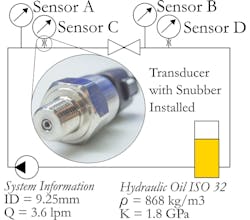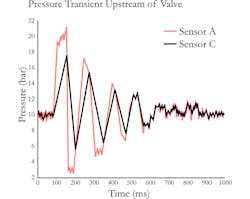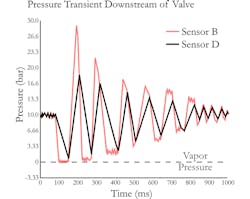Pressure peaks in a hydraulics can break pressure sensors and cause damages far higher than the price of a humble pressure snubber that could have prevented them. So, what are they and when should they be used?
Sometimes small oversights such as a sudden valve opening or closing can cascade into larger problems, creating pump ripple or fluid hammer. These problems “confuse” pressure sensors so that signals become noisy, cycle life is reduced and, in some cases, there are catastrophic failures. All these headaches and unforeseen costs can be avoided with a simple snubber to limit the amplitude of pressure transients.
Surge Basics
Pressure transients occur daily in plumbing fixtures. Shutting off a shower too quickly can cause an audible bang, a symptom of fluid (water) hammer. This happens when there is a sudden change in the rate of fluid flow, usually caused by a pump or valve operation. Whenever flow or the moving fluid’s momentum changes rapidly, a pressure wave begins building and travels through the piping, causing it to vibrate and possibly destroy sensitive components.
A standard approximation for calculating the pressure transient is the Joukowsky equation. This formula determines the pressure change due to a change in fluid velocity:
ΔP= -ρ√(K/ρ) ΔV
Where ΔP is the pressure change (sometimes called surge), ρ is the fluid density, √(K/ρ) is a conservative calculation of wave speed, K is the fluid’s bulk modulus and ΔV is the change in velocity.
Take, for example, a hydraulic system that has sensors before and after a valve (see figure above). The system runs at 10 bar and has a flow rate of 3.6 lpm before the valve is suddenly closed, creating a pressure wave of 11.2 bar that moves through the system. This pressure wave will continue moving until its energy is completely dissipated.
Overall, there are two concerns with unprotected pressure sensors: the pressure surge and the possibility of cavitation. The primary concern is whether the pressure surge will exceed the sensor’s overpressure limits. But, pressures from cavitation can exceed the pressure surge and are more harmful to pressure sensors. Cavitation is created by a negative pressure transient lowering pressure than the fluid’s vapor pressure. This leads to vapor bubbles forming and collapsing. Collapsing vapor bubbles expose the sensor to excessive localized pressures.
Sensor B, in Fig. 1, is at risk of cavitation as it sees pressures below the fluid’s vapor pressure immediately after the valve closes.
To understand how pressure transients damage sensors, you must understand how the sensor works. Pressure sensors are designed for specific pressure ranges. The sensing element is commonly a strain gauge on a thin diaphragm. The diaphragm’s design is a compromise between its sensitivity and safety; it can elastically deform at its rated capacity and be accurate, but if the pressure transient is too high, it deforms plastically (permanently) or ruptures. Either way the sensor is destroyed.
Manufacturers test pressure sensors to set overload pressure ratings, and it is generally done quasi-statically as most pressure sensors are quasi-static measurement devices. But pressure transients are not static and can cause failure even at pressures below the overload pressure rating. To mitigate this issue, a snubber reduces the dynamic pressures a sensor experiences during pressure transients.
The Snubber
A pressure snubber is an ancillary component with a small profile that is attached to the pressure sensor. It limits the fluid’s rate of pressure change by restricting the fluid flow through a smaller fitting. As fluid flow is limited, the sudden pressure rise is delayed downstream as fluid needs time to pass through the restriction. This lets pressure spikes be filtered out, but quasi-static pressure changes will pass through.
The snubber effectively suppresses the pressure peaks from passing through the fitting (above). After the valve closes, the pressure rise in Sensor C is limited and it sees lower dynamic pressures.
On the other side, the pressure drop in Sensor D is slowed and its internal cavity pressure does not drop below the vapor pressure, which means harmful cavitation does not destroy it. As an added benefit, these sensors are exposed to a smaller stress amplitudes and it will take longer before they experience fatigue failure. The only drawback of a snubber is that by its function it slows down the mechanical response time of the pressure sensor so it should not be used for capturing dynamic pressures.
Although the above example shows a simple hydraulic system, more complex systems, particularly those with several branches, are harder to predict fluid hammers locations or magnitudes. There is pressure transient simulation software for complex systems, but it may not be cost-effective. All this makes it prudent to preemptively install snubbers rather than risk system downtime. The bottom line: A pressure sensor will last longer with one than without one.
Gregory Seviora is a product designer at Anfield Sensors Inc.
About the Author
Gregory Seviora
Product Designer, Anfield Sensors Inc.

Leaders relevant to this article:



